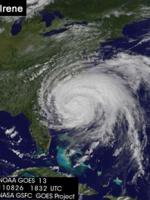
Social Media in Times of Emergency

In the month of August, the East Coast was hit with two natural disasters, one foreseen, Hurricane Irene, and one without notice, the August 23rd earthquake. Though one primary form of established media failed—phone service during the earthquake was interrupted for many, if not most—both government agencies and individual citizens used social media to learn about what was happening and to communicate while each emergency progressed.
As the Congressional Research Service states in its September 06, 2011, publication, “Social Media and Disasters: Current Uses, Future Options, and Policy Considerations,” government bodies turned to social media at three different times for vastly different purposes: first in preparing for a disaster; then in responding; and finally for recovering. Then, there are different platforms through which people access social media, the two most important being mobile (which itself includes three distinct devices: cell phones, smartphones, and, increasingly, tablets), and PC-type platforms. Finally, there are a few critical tasks that governments can achieve through social media: preparing citizens in areas likely to be affected by a disaster; broadcasting real-time information both for affected areas and interested people; receiving real-time data from affected areas; mobilizing and coordinating immediate relief efforts; optimizing recovery activities.
Over the coming weeks, this blog series will explore each of these in detail. This introduction, however, will sketch out which tools government agencies used, how and when they used them, and what they used them for.
Three ways and times to use social media
Here is how the CRS characterizes government agencies’ use of social media before, during, and after an emergency. Detailing certain agencies’ activities in each of these areas will be the focus of the next blog post.
- Preparing for a disaster: though no one can predict an earthquake days in advance, as this somewhat cheeky video shows, Twitter did give some people notice of the quake's arrival. The hurricane, however, was widely foreseen, and as word went out on television channels, governments turned also to Twitter and Facebook—as well as email and text messaging—to help citizens prepare for the emergency.
- Responding during and immediately after the event: government agencies are realizing that people are attuned to their social media streams far more often than they are to almost any other form of media. This is especially the case for SMS messages and other communications that can be received through cellphones. Further, government agencies are recognizing that they can ask people to report on their condition and the condition of their surroundings, the better for government to be able to respond.
- Recovering from the event in the weeks and months after: the status of infrastructure, operations of schools and government offices, and other affected systems are all being communicated through social media.
Platforms through which people access social media
The CRS makes a special note about the technical limitations of certain technologies—for example, the battery life of tablets and smartphones. One of the posts in this series will examine how the platform through which people are able to access social media has shaped the kind and format of the information that governments need to communicate.
- Mobile (cell phones, smartphones, and, increasingly, tablets): though this is an important platform for preparation and recovery, it is indispensable for gathering data during an emergency and performing rapid-response activities. Though it is possible to develop event-specific apps and mobile Web sites, many agencies simply turn to the mobile versions of Twitter and/or Facebook, or use the SMS capabilities intrinsic to all cell phones (not only smartphones).
- PC-type platforms: The level of detail available through PCs is unmatched by mobile devices, which makes it a preferred platform for preparation and recovery. The platform is also ideally suited to providing those outside affected areas with a wealth of information either to allay their concerns or to empower them to take independent action.
Critical tasks that governments can achieve through social media
The final post on this topic will synthesize the final sections of the CRS report, and will detail how specific agencies are using social media on their own and in concert with organizations and individual citizens to:
- Prepare citizens in areas likely to be affected by a disaster;
- Broadcast real-time information both for affected areas and interested people;
- Receive real-time data from affected areas;
- Mobilize and coordinating immediate relief efforts; and
- Optimize recovery activities.



